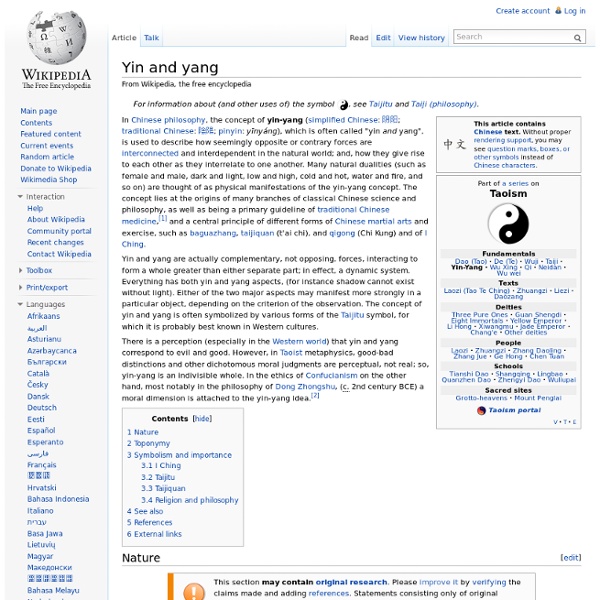Yin and yang

Wu Xing
Diagram of the interactions between the Wu Xing. The "generative" cycle is illustrated by white arrows running clockwise on the outside of the circle, while the "destructive" or "conquering" cycle is represented by red arrows inside the circle. Some of the Mawangdui Silk Texts (no later than 168 BC) also present the Wu Xing as "five virtues" or types of activities.[7] Within Chinese medicine texts the Wu Xing are also referred to as Wu Yun (五運 wŭ yùn) or a combination of the two characters (Wu Xing-Yun) these emphasise the correspondence of five elements to five 'seasons' (four seasons plus one). Another tradition refers to the wŭ xíng as wŭ dé 五德, the Five Virtues (zh:五德終始說). The system of five phases was used for describing interactions and relationships between phenomena. The Phases[edit] The five phases are usually used to describe the state in nature: Cycles[edit] Inter-promoting (mother/son)Inter-acting (grandmother/grandson)Over-acting (kè cycle)Counter-acting (reverse kè) Bagua[edit]
Chinese herbology
Dried herbs and plant portions for Chinese herbology at a Xi'an market Chinese herbology (simplified Chinese: 中药学; traditional Chinese: 中藥學; pinyin: zhōngyào xué) is the theory of traditional Chinese herbal therapy, which accounts for the majority of treatments in traditional Chinese medicine (TCM). The term herbology is misleading in the sense that, while plant elements are by far the most commonly used substances, animal, human, and mineral products are also utilized. Thus, the term "medicinal" (instead of herb) is usually preferred as a translation for 药 (pinyin: yào).[1] The effectiveness of traditional Chinese herbal therapy remains poorly documented.[2] There are concerns over a number of potentially toxic Chinese herbs.[3] History[edit] Chinese pharmacopoeia Chinese herbs have been used for centuries. The first traditionally recognized herbalist is Shénnóng (神农, lit. Raw materials[edit] Some animal parts used as medicinals can be considered rather strange such as cows' gallstones.[12]
Kōan
A kōan (公案?)/ˈkoʊ.ɑːn/; Chinese: 公案; pinyin: gōng'àn; Korean: 공안 (kong'an); Vietnamese: công án) is a story, dialogue, question, or statement, which is used in Zen-practice to provoke the "great doubt", and test a student's progress in Zen practice. Etymology[edit] According to the Yuan Dynasty Zen master Zhongfeng Mingben (中峰明本 1263–1323), gōng'àn originated as an abbreviation of gōngfǔ zhī àndú (公府之案牘, Japanese kōfu no antoku—literally the andu "official correspondence; documents; files" of a gongfu "government post"), which referred to a "public record" or the "case records of a public law court" in Tang-dynasty China. Commentaries in kōan collections bear some similarity to judicial decisions that cite and sometimes modify precedents. Gong'an was itself originally a metaphor—an article of furniture that came to denote legal precedents. Origins and development[edit] China[edit] [edit] Those stories came to be known as gongan, "public cases". Literary practice[edit] Interaction[edit]
Related:
Related:



